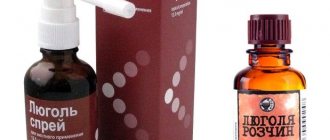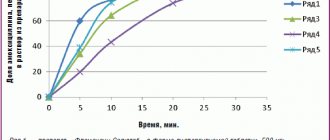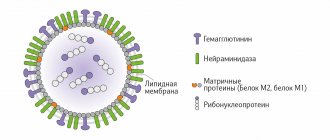How to do inhalation correctly
A person can get sick at any time of the year.
There are many reasons for this: weak immunity, sudden changes in temperature, a banal draft and much more. Modern parents do not want to give their child strong medications once again, because any drug has many side effects, and adults often suffer from allergies to pills. Regular saline solution can help both. It helps eliminate rhinitis, laryngitis, pharyngitis, bronchitis, pneumonia and many other respiratory diseases. If you didn’t know, saline solution can be prepared even at home. To do this, you need to take 1 liter of boiled water and 10 grams of salt. Mix the salt thoroughly and the solution is ready. It should be stored in the refrigerator for no more than a day. Otherwise, instead of having a therapeutic effect, it will have the opposite. Before using the solution, it must be heated. But you should be careful, because the mucous membrane of the nasopharynx is very delicate and can easily be burned.
Sodium Chloride Bufus 0.9% 10 ml N10 injection solution
Release form
Solution.
Package
per package 10 ampoules of 5 ml.
100 ml - glass bottles
pharmachologic effect
Sodium chloride is a drug that acts as a rehydrating and detoxifying agent. The medicine is able to compensate for the lack of sodium in the body, subject to the development of various pathologies. Sodium chloride also increases the amount of fluid that circulates in the vessels.
Such properties of the solution are manifested due to the presence of chloride ions and sodium ions in it. They are able to penetrate the cell membrane using various transport mechanisms, in particular the sodium-potassium pump. Sodium plays an important role in the process of signal transmission in neurons; it is also involved in the metabolic process in the kidneys and in the electrophysiological processes of the human heart.
Indications
Sodium chloride is a saline solution that is used when the body loses extracellular fluid. Indicated for conditions that lead to limited fluid intake:
- dyspepsia due to poisoning;
- vomiting, diarrhea;
- cholera;
- extensive burns;
- hyponatremia or hypochloremia, in which dehydration is noted.
Considering what sodium chloride is, it is used externally to wash wounds, eyes, and nose. The drug is used to moisturize dressings, for inhalation, and for the face.
The use of NaCl is indicated for forced diuresis in cases of constipation, poisoning, and internal bleeding (pulmonary, intestinal, gastric).
It is also indicated in the indications for use of sodium chloride that this is a drug that is used for diluting and dissolving drugs that are administered parenterally.
Contraindications
The use of the solution is contraindicated for the following diseases and conditions:
- hypokalemia, hyperchloremia, hypernatremia;
- extracellular hyperhydration, acidosis;
- pulmonary edema, cerebral edema;
- acute left ventricular failure;
- development of circulatory disorders, in which there is a threat of cerebral and pulmonary edema;
- prescription of large doses of GCS.
The solution is prescribed with caution to people who suffer from arterial hypertension, peripheral edema, decompensated chronic heart failure, chronic renal failure, preeclampsia, as well as those diagnosed with other conditions in which sodium retention occurs in the body.
If the solution is used as a diluent for other medications, existing contraindications should be taken into account.
special instructions
If an infusion is given, the patient's condition should be carefully monitored, in particular plasma electrolytes. It should be taken into account that in children, due to immature renal function, sodium excretion may slow down. It is important to determine its plasma concentration before repeated infusions.
It is important to monitor the condition of the solution before administering it. The solution must be transparent and the packaging undamaged. Only a qualified specialist can use the solution for intravenous administration.
Any preparations with Sodium Chloride should only be dissolved by a specialist who can qualifiedly assess whether the resulting solution is suitable for administration. It is important to strictly adhere to all antiseptic rules. Any solution should be administered immediately after its preparation.
The result of a series of chemical reactions involving sodium chloride is the formation of chlorine. Electrolysis of molten Sodium Chloride in industry is a method of producing chlorine. If you carry out electrolysis of a solution of Sodium Chloride, you also end up with chlorine. If crystalline Sodium Chloride is treated with concentrated sulfuric acid, the result is hydrogen chloride. Sodium sulfate and sodium hydroxide can be produced through a chain of chemical reactions. A qualitative reaction to chloride ion is a reaction with silver nitrate.
Compound
The active ingredient of this product is sodium chloride. The formula for sodium chloride is NaCl, these are white crystals that quickly dissolve in water. Molar mass 58.44 g/mol. OKPD code - 14.40.1.
Saline solution (isotonic) is a 0.9% solution, it contains 9 g of sodium chloride, up to 1 liter of distilled water.
Hypertonic sodium chloride solution is a 10% solution, it contains 100 g of sodium chloride, up to 1 liter of distilled water.
Directions for use and doses
The instructions for saline solution (isotonic solution) provide for its administration intravenously and subcutaneously.
In most cases, intravenous drip administration is practiced, for which the Sodium Chloride dropper is heated to a temperature of 36-38 degrees. The volume that is administered to the patient depends on the condition of the patient, as well as the amount of fluid that has been lost by the body. It is important to take into account the person’s age and weight.
The average daily dose of the drug is 500 ml, the solution is administered at an average speed of 540 ml/h. If there is a severe degree of intoxication, then the maximum volume of medication per day can be 3000 ml. If there is such a need, a volume of 500 ml can be administered at a speed of 70 drops per minute.
Children are given a dose of 20 to 100 ml per day per 1 kg of weight. The dosage depends on body weight and the age of the child. It should be borne in mind that with prolonged use of this medicine it is necessary to monitor the level of electrolytes in plasma and urine.
To dilute drugs that need to be administered by drip, use 50 to 250 ml of sodium chloride per dose of the drug. The characteristics of administration are determined based on the main drug.
The hypertonic solution is administered intravenously.
If the solution is used to immediately compensate for the deficiency of sodium and chlorine ions, 100 ml of the solution is injected dropwise.
To perform a rectal enema to induce defecation, 100 ml of a 5% solution is administered; 3000 ml of an isotonic solution can also be administered throughout the day.
The use of a hypertensive enema is slowly indicated for renal and cardiac edema, increased intracranial pressure and for hypertension, it is carried out slowly, 10-30 ml is administered. Such an enema cannot be performed in case of colon erosion and inflammatory processes.
Purulent wounds are treated with a solution according to the regimen prescribed by the doctor. Compresses with NaCl are applied directly to a wound or other lesion on the skin. Such a compress promotes the separation of pus and the death of pathogenic microorganisms.
The nasal spray is instilled into the nasal cavity after it has been cleansed. For adult patients, two drops are instilled into each nostril, for children - 1 drop. It is used for both treatment and prevention, for which the solution is dripped for about 20 days.
Sodium chloride for inhalation is used for colds. To do this, the solution is mixed with bronchodilators. Inhalation is carried out for ten minutes three times a day.
If absolutely necessary, saline solution can be prepared at home. To do this, mix a full teaspoon of table salt in one liter of boiled water. If it is necessary to prepare a certain amount of solution, for example, with salt weighing 50 g, appropriate measurements should be taken. This solution can be applied topically, used for enemas, rinses, and inhalations. However, under no circumstances should such a solution be administered intravenously or used to treat open wounds or eyes.
Side effects
The following conditions may develop when using sodium chloride:
- overhydration;
- hypokalemia;
- acidosis.
If the drug is used correctly, the development of side effects is unlikely.
If a 0.9% NaCl solution is used as a base solvent, then side effects are determined by the properties of the drugs that are diluted with the solution.
If any negative effects occur, you should immediately report it to a specialist.
Drug interactions
NaCl is compatible with most medications. It is this property that determines the use of the solution for diluting and dissolving a number of drugs.
When diluting and dissolving, it is necessary to monitor the compatibility of drugs visually, determining whether a precipitate appears during the process, whether the color changes, etc.
Does not combine well with norepinephrine.
When concomitantly prescribing the drug with corticosteroids, it is important to constantly monitor the levels of electrolytes in the blood.
When taken in parallel, the hypotensive effect of Enalapril and Spirapril decreases.
Sodium Chloride is incompatible with the leukopoiesis stimulator Filgrastim, as well as with the polypeptide antibiotic Polymyxin B.
There is evidence that isotonic solution increases the bioavailability of drugs.
When diluted with a solution of powdered antibiotics, they are completely absorbed by the body.
Overdose
In case of overdose, the patient may feel nausea, suffer from vomiting and diarrhea, he may develop abdominal pain, fever, and rapid heartbeat. Also, in case of an overdose, blood pressure may increase, pulmonary edema and peripheral edema, renal failure, muscle cramps, weakness, dizziness, generalized convulsions, and coma may develop. If the solution is administered excessively, hypernatremia may develop.
With excessive intake into the body, hyperchlorimic acidosis may develop.
If sodium chloride is used to dissolve drugs, then the overdose is mainly associated with the properties of those drugs that are diluted.
If NaCl is inadvertently overadministered, it is important to stop this process and assess whether the patient has any more negative symptoms. Symptomatic treatment is practiced.
Storage conditions
The powder, tablets and solution should be stored in a dry place, in a well-closed container, and the temperature should not exceed 25 degrees Celsius. It is important to keep the drug away from children. If the packaging is sealed, freezing does not affect the properties of the drug.
Best before date
The solution in 0.9% ampoules can be stored for 5 years; solution in bottles 0.9% - one year, solution in bottles 10% - 2 years. Cannot be used after the shelf life has expired.
Conditions for dispensing from pharmacies
On prescription
Inhalation of saline solution for cough
Why is saline solution the best of all medicines? Everything is very simple. Small children do not know how to swallow pills, and pharmaceuticals have many side effects; drops almost immediately enter the esophagus; ointments linger on the mucous membrane, but practically do not reach the respiratory tract; The effect of aerosols is short-term.
What are the advantages of saline solution? The use of this product does not cause allergies or other side effects, and has a moisturizing effect on the nasopharyngeal mucosa. In addition, salt is a good antiseptic. When it comes into contact with the mucous membrane, it kills pathogenic bacteria. Salt also softens coughs and helps remove phlegm from the lungs.
Is it possible to dilute ceftriaxone sodium chloride and lidocaine?
Ceftriaxone is an effective antibiotic that is often administered intramuscularly or intravenously. Due to the severe pain caused by injection through the muscle, it is recommended to dilute the antibiotic with an effective anesthetic - lidocaine, with the caveat that the patient is not intolerant of such anesthesia. In addition, for proper dosing, special bottles with water are used to dilute the drug. It is sterile and is used to mix the antibiotic and anesthetic.
In the absence of an aqueous solvent, you can take a package of sodium chloride to dilute the drugs with it. However, you need to remember that a homemade remedy will not work. It is necessary to have a sterile bottle of saline solution.
Sodium chloride is the composition that is the basis of all droppers. In a hospital setting, or at home under the supervision of a specialist, the patient is administered drugs using the drip method, which allows you to quickly get the effect of the procedure. Saline solution, being a copy of blood plasma, allows the drug to enter the body gently, evenly distributing its substances throughout the body.
How to do inhalation with saline solution?
To carry out medical procedures, it is still better to take saline solution at the pharmacy, because it is sold there in sterile form.
To eliminate a cough, you need to pour saline solution into the inhaler and deeply inhale its vapors. For severe coughs, medications can be added to the medicinal fluid.
For dry cough, the drugs “Berodual” or “Pulmicort” are prescribed. When it is wet, it is better to use Lazolvan, ACC, and Fluimucil. You can also add antibiotics to the saline solution: “Bioparox”, “Fluimucil”, etc.
We must remember the importance of temperature. For children under 3 years old, the saline solution should be no warmer than 30 degrees, for children under 5 years old – 40 degrees. From 6 years of age, you can use a medicinal liquid at a temperature of 52 degrees, and for adults - at 54 degrees.
For children under three years of age, inhalations can be done once a day, from 3 years of age and for adults - three times a day. The course of treatment will depend on the type of cough and the presence of complications, as well as on age.
What is a nebulizer?
A nebulizer is a special device in which medicinal liquids are converted into drops. The latter, when they get on the mucous membrane of the nasopharynx or lungs, penetrate inside and have a very good therapeutic effect.
What differences does this saline inhalation have? The nebulizer can be used by both the smallest children and the elderly. The thing is that when using this device you do not need to take a strong breath or adapt to its operation. Inhale when it is convenient for you. The medicine does not evaporate anywhere, but is located in a special tank.
The saline solution breaks down into small particles using a special compressor built into the device and powered by the network.
In what cases is hypertonic sodium chloride solution used?
A hypertonic solution is a concentrated sodium chloride solution that contains more salts than an isotonic solution. It is used for several indications. A hypertonic solution has a direct effect on the fluids in the body. It draws water out of cells. Therefore, it is prescribed to patients with cerebral edema. In addition, the solution helps increase blood pressure during blood loss.
It is often used to treat wounds - salt is a natural antiseptic. Patients with arthritis make compresses that relieve pain, reduce inflammation and swelling. For diseases of the oral cavity, it is recommended to rinse with a hypertonic solution, and for sinusitis, rinse the nose with it.
Basic rules for inhalation with a nebulizer
Wash your hands thoroughly.
2. Assemble the nebulizer.
3. Prepare the medicinal substance and heat it to the required temperature.
4. Pour the solution into the nebulizer cup.
5. Close the device tightly and attach a face mask, mouthpiece, or nasal cannula.
6. Connect the nebulizer to the compressor.
7. Turn on the compressor and begin to inhale the medicine.
8. After completing the procedure, turn off the compressor and disconnect the device.
9. Wash all parts of the nebulizer with a 15% soda solution.
10. Boil everything for 10 minutes.
11. Dry the components of the device and store them in a clean cloth.
Carrying out the procedure for a runny nose
Inhalation with saline solution can be performed even on newborn children. Once on the nasal mucosa, the medicinal liquid softens it and promotes the removal of mucus. If you have a runny nose, the procedure should be done every 4 hours. Treatment should be started at the first manifestations of the disease; if the disease has been going on for several days, saline solution will not help. The use of medications will be required.
You can add various essential oils, for example, pine needles, eucalyptus, to inhalation with saline solution. Aloe or Kalanchoe juice is also used. But all these means must be used with caution. Very often they cause allergies.
Buy Sodium chloride solution for injection 0.9% 10ml No. 10 Bufus in pharmacies
Instructions for use
Sodium chloride solution d/in. 0.9% 10ml No. 10 Bufus
Dosage forms injection solution 0.9% 10ml Synonyms Aqua-rinosol AquaMaster Nazol Aqua Sodium chloride
Physiodosis
Group Plasma replacement saline solutions International nonproprietary name Sodium chloride Composition Active ingredient - Sodium chloride. Manufacturers Update PFC (Russia) Pharmacological action Plasma-substituting, detoxifying, hydrating, normalizing acid-base state. Sodium chloride solution (0.9%) is isotonic with human blood plasma and is therefore quickly cleared from the vascular bed, only temporarily increasing the volume of circulating fluid, so its effectiveness in cases of blood loss and shock is insufficient. Hypertonic solutions (3-5-10%) are used intravenously and externally. When applied externally, they promote the release of pus and exhibit antimicrobial activity; when administered intravenously, they increase diuresis and replenish the deficiency of sodium and chloride ions (for example, with severe vomiting). Nasal spray: Moisturizes the nasal mucosa, thins thick mucus, softens dry crusts in the nose and facilitates their easy removal. Has a substitutive effect for disorders of nasal secretion. Restores the patency of the nasal passages, facilitates nasal breathing by moisturizing the mucous membrane and thinning the mucus. Side effects Allergic reactions are possible. Indications for use A solution of 0.9% is used as a detoxification agent, to correct dehydration, and to dissolve other medications; hypertonic solutions - for pulmonary, gastric and intestinal bleeding as an auxiliary osmotic diuretic to ensure forced diuresis, in conditions leading to a deficiency of sodium and chlorine ions, in case of silver nitrate poisoning, for the treatment of purulent wounds (locally). Nasal spray: hygienic care for the nasal mucosa of adults and children (including infants), gentle and quick cleansing of the nasal cavity from viscous mucus and crusts; — dryness of the nasal mucosa, including that which occurs when working in dusty rooms or working with paints and varnishes, during prolonged stays in air-conditioned rooms; - sinusitis, rhinitis of various etiologies (in complex treatment), after Contraindications Hypersensitivity. Restrictions on use. Renal dysfunction and heart failure (for large volumes of isotonic solution). Children under 3 years of age for spray with menthol 0.65% or 0.9%. Method of administration and dosage The isotonic solution is administered intravenously. In case of dehydration and intoxication, the daily dose can be increased to 3000 ml. Overdose No data available. Interaction No data available. Special instructions No data available. Storage conditions : Protected from light, at a temperature not exceeding 25 °C.








